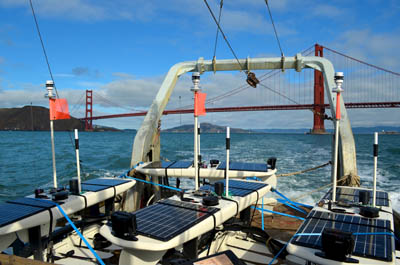The Papa Mau robot, after landing at at Hervey Bay in Australia this week. Image via Liquid Robotics
A wave-powered robot has completed a 9,000 nautical mile journey from San Francisco, California, to Australia after setting off just over a year ago to collect and transmit scientific data in real-time from the Pacific Ocean.
California ocean data company Liquid Robotics created the robot, known as Papa Mau.
The company has pioneered and developed the Wave Glider, a wave-powered autonomous robot. On 17 November 2011, Liquid Robotics launched four Wave Gliders – including Papa Mau – from San Francisco to travel across the Pacific Ocean to gather and transmit scientific data on waves, weather, salinity, water temperature, and dissolved oxygen.
The Wave Gliders harvest energy from ocean waves in order to travel across the ocean, while they also have solar panels for computing and navigation and to power its sensors.
This week, the Papa Mau robot arrived at Hervey Bay near Bundaberg in Queensland, Australia, following its 9,000 nautical mile (16,668km) voyage across the Pacific Ocean.
“During Papa Mau‘s journey, he weathered gale-force storms, fended off sharks, spent more than 365 days at sea, skirted around the Great Barrier Reef, and finally battled and surfed the east Australian current to reach his final destination in Hervey Bay near Bundaberg, Queensland, Australia,” said the company in a statement.
Liquid Robotics said the robot travelled through and measured more than 1,200 miles (1,931km) of chlorophyll bloom along the equatorial Pacific.
“These blooms indicate proliferation of phytoplankton that is fundamental to ocean life and climate regulation,” it said.
Phytoplankton are microscopic plant-like organisms that provide food for other marine life and play a key role in consuming carbon dioxide during photosynthesis.
While satellites can monitor chlorophyll blooms, Liquid Robotics suggested its technology can provide images of the phytoplankton in more detail for marine and climate change scientists.

The Papa Mau marine robot prior to the launch of its Pacific Ocean voyage in San Francisco in November 2011
“We set off on the PacX journey to demonstrate that Wave Glider technology could not only survive the high seas and a journey of this length, but more importantly, collect and transmit ocean data in real-time from the most remote portions of the Pacific Ocean,” said Bill Vass, CEO of Liquid Robotics.
The company’s second ocean robot is also destined for Australia and is expected to land in early 2013. The remaining two robots are heading for Japan, but one of them, Fontaine Maru, has been damaged and is returning to Hawaii to be repaired.